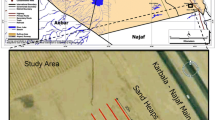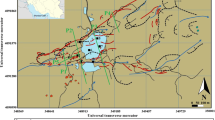Abstract
Two-dimensional (2-D) electrical resistivity imaging (ERI) technique has been used to characterize a landslide which occurred in a ridgeway between Burdur and Isparta in southern Turkey. The problems related to this road showed an increase due to road constructions and heavy rainfall. Primary attention was drawn to the determination of the thickness of the mobilized material, its possible sliding surface, and evaluation of the groundwater conditions related to the occurrence of the landslide. The eight survey profiles in the landslide area were implemented. Electrical resistivity survey has been carried out by the Wenner–Schlumberger array for data acquisition and smoothness-constrained least-squares method for data inversion. The self-potential (SP) survey data are presented as one-dimensional profile for each of the lines. ERIs pointed out a great heterogeneity of the near surface or mobilizing material and presence of impermeable material that could be associated to lateral and vertical limits of permeability. SP anomalies displayed that the positive values were located in water discharge on the surface whereas negatives in the sites of infiltration. The sliding surface is at a depth of about 10 m.








Similar content being viewed by others
References
Atayeter Y (2004) Landslides on the ridgeway between Gelincik (Isparta)-Askeriye (Burdur) villages. Burdur J Educ Fac 8:17–31
Bogoslovsky VA, Ogilvy AA (1977) Geophysical methods for the investigation of landslides. Geophysics 42:562–571
Carpentier S, Konz M, Fischer R, Anagnostopoulos G, Meusburger K, Schoeck K (2012) Geophysical imaging of shallow subsurface topography and its implication for shallow landslide susceptibility in the Urseren Valley. Switzerland, J Appl Geophys 83:46–56
Chambers JE, Wilkinson PB, Kuras O, Ford JR, Gunn DA, Meldrum PI, Pennington CVL, Weller AL, Hobbs PRN, Ogilvy RD (2011) Three-dimensional geophysical anatomy of an active landslide in Lias Group mudrocks, Cleveland Basin, UK. Geomorphology 125:472–484. doi:10.1016/j.jappgeo.2012.05.001
Colangelo G, Lapenna V, Perrone A, Piscitelli S, Telesca L (2006) 2D Self-Potential tomographies for studying groundwater flows in the Varco d’Izzo landslide (Basilicata, southern Italy). Eng Geol 88:274–286
Cosenza P, Mannet E, Rejiba F (2006) Correlations between geotechnical and electrical data: a case study at Garchy in France. J Appl Geophys 60:165–178. doi:10.1016/j.jappgeo.2006.02.003
Dahlin T, Zhou B (2004) A numerical comparison of 2D resistivity imaging with 10 electrode arrays. Geophys Prospect 52:379–398. doi:10.1111/j.1365-2478.2004.00423.x
Friedel S, Thielen A, Springman SM (2006) Investigation of a slope endangered by rainfall-induced landslides using 3D resistivity tomography and geotechnical testing. J Appl Geophys 60:100–114. doi:10.1016/j.jappgeo.2006.01.001
Grandjean G, Gourry JC, Sanchez O, Bitri A, Garambois S (2011) Structural study of the Ballandaz landslide (French Alps) using geophysical imagery. J Appl Geophys 75:531–542. doi:10.1016/j.jappgeo.2011.07.008
Hibert C, Grandjean G, Bitri A, Travelletti J, Malet JP (2012) Characterizing landslides through geophysical data fusion: example of the La Valette landslide (France). Eng Geol 128:23–29. doi:10.1016/j.enggeo.2011.05.001
Jomard H, Lebourg T, Tric E (2007) Identification of the gravitational boundary in weathered gneiss by geophysical survey: La Clapière landslide (France). J Appl Geophys 62:47–57. doi:10.1016/j.jappgeo.2006.07.003
Lapenna V, Lorenzo P, Perrone A, Piscitelli S, Rizzo E, Sdao F (2005) 2D electrical resistivity imaging of some complex landslides in the Lucanian Apennine chain, southern Italy. Geophysics 70:11–18. doi:10.1190/1.1926571
Lee CC, Yang CH, Liu HC, Wen KL, Wang ZB, Chen YJ (2008) A Study of the hydrogeological environment of the lishan landslide area using resistivity image profiling and borehole data. Eng Geol 98:3–4. doi:10.1016/j.enggeo.2008.01.012
Loke MH (2013) Tutorial: 2-D and 3-D electrical imaging surveys. http://www.geotomosoft.com. Accessed 24 June 2013
Loke MH, Barker RD (1996) Rapid least-squares inversion of apparent resistivity pseudosections by a quasi-Newton method. Geophys Prospect 44:131–152. doi:10.1111/j.1365-2478.1996.tb00142.x
Loke MH, Acworth I, Dahlin T (2003) A comparison of smooth and blocky inversion methods in 2-D electrical imaging surveys. Explor Geophys 34:182–187
Martorana R, Fiandaca G, Ponsati AC, Cosentino PL (2009) Comparative tests on different multi-electrode arrays using models in near-surface geophysics. J Geophys Eng 6:1–20. doi:10.1088/1742-2132/6/1/001
Piegari E, Cataudella V, Di Maio R, Milano L, Nicodemi M, Soldovieri MG (2009) Electrical resistivity tomography and statistical analysis in landslide modelling: a conceptual approach. J Appl Geophys 68:151–158. doi:10.1016/j.jappgeo.2008.10.014
Revil A, Pezard PA, Glover PWJ (1999) Streaming potential in porous media. 1. Theory of the zeta potential. J Geophys Res 104:20021–20031
Sastry RG, Mondal SK (2013) Geophysical characterization of the Salna Sinking Zone, Garhwal Himalaya, India. Surv Geophys 34:89–119. doi:10.1007/s10712-012-9206-y
Sener E, Davraz A, Ozcelik M (2005) An integration of GIS and remote sensing in groundwater investigations: a case study in Burdur, Turkey. Hydrogeol J 13:826–834. doi:10.1007/s10040-004-0378-5
Telford WM, Geldart LP, Sheriff RE (1990) Applied geophysics, Second Editionth edn. Cambridge University Press, Cambridge
Yilmaz S (2007) Investigation of Gürbulak landslide using 2D electrical resistivity image profiling method (Trabzon, northeastern Turkey). J Environ Eng Geophys 12:199–205. doi:10.2113/JEEG12.2.199
Acknowledgments
Financial support by the Süleyman Demirel University Research Fund is gratefully acknowledged. The authors would like to thank to the anonymous reviewers for their constructive comments which have helped to improve this manuscript.
Author information
Authors and Affiliations
Corresponding author
Rights and permissions
About this article
Cite this article
Yılmaz, S., Narman, C. 2-D electrical resistivity imaging for investigating an active landslide along a ridgeway in Burdur region, southern Turkey. Arab J Geosci 8, 3343–3349 (2015). https://doi.org/10.1007/s12517-014-1412-0
Received:
Accepted:
Published:
Issue Date:
DOI: https://doi.org/10.1007/s12517-014-1412-0




